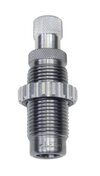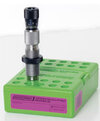The Glockodile
Member
- Joined
- May 6, 2020
- Messages
- 1,688


1) Ignoring the carbide sizing component, is there any significant difference between the type of crimp each delivers? For instance, as far as Redding’s rimmed cartridge dies are concerned…
Redding Profile Crimp die with 38 Spl
I just received my Redding Profile Crimp Die fir 38/357. Once I adjust the die to touch an empty case, I lower the ram and do one complete turn of the die downwards and then start crimping loaded rounds. The crimp does not seem too significant with just one turn. How much do you crimp with...
castboolits.gunloads.com
Die is adjustable. With light contact it produces a taper crimp in varying degrees, depending upon adjustment.
Turned down more the die produces a roll crimp, which is VERY substantial if die body contacts shell holder and you haven't trimmed cases!
2) Ignoring the presence of the carbide component and the micrometer hashes, does one have any significant benefit over the other?

